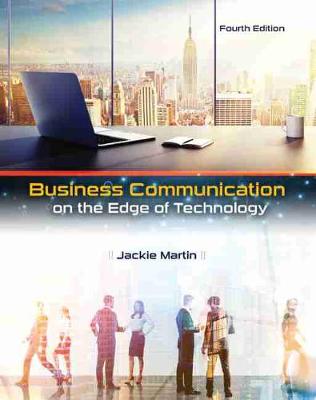Business Communication on the Edge of Technology combines a textbook (print / eBook) and companion website creating a package that students place on their office shelves!
Business Communication on the Edge of Technology begins with the theory of written and oral communication, and then directs students to analyze business situations and to plan, organize, write, and revise letters, memos, emails, and written and oral reports, applying the principles of ethical and effective communication. Students also create and revise industry standard reports such as white papers using word processing software and presentation-graphics software to create and deliver professional-level oral reports. Messages are broken into their component parts for a critical analysis of organization and content, style, tone, grammar, format, and appearance.
Specific topics and assignments include: direct request and direct reply; negative (bad news); persuasive messages; employment-related documents (e.g., a resume, cover letter and e-portfolio); an analytical report which analyzes a problem or question, compares and contrasts alternative solutions, includes properly inserted visuals, page numbers and an associated table of contents, citations and a works cited page; includes documented sources, an executive summary, and provides conclusions and recommendations; and an oral presentation, using presentation software and/or audio-video multimedia, to persuade an audience.
Companion Website includes PowerPoint presentations of each Chapter, automated True/False and Multiple Choice quizzes for each Chapter; Resources that include sample writing and PowerPoint presentations with detailed notes that assist students with content, format, and software functions.
At the conclusion of this course, the student should be able to:
- Explain the elements of the communication process.
- Analyze how word selection and usage affects communication.
- Solve business communication problems through planning, problem solving, organizing, writing, listening and presenting techniques.
- Illustrate sensitivity to audience needs and desire, including cross-cultural situations.
- Plan, organize, write and revise letters, memos, emails, and reports suitable for a variety of business situations, including quantitative (e.g., accounting and finance) and business legal contexts.
- Plan and deliver individual or team oral-presentations for business meetings.
- Understand communication in an internationalization and globalization context.
- Identify a basic logical fallacy in an oral or written context.
- Select a proper delivery format face-to-face v. electronic and identify the strengths of each modality.
- Understand uses of social media and related Internet writing contexts.
- Adjust composition, prose, and rhetorical language use for optimal conciseness and clarity.
- Demonstrate an understanding of social etiquette applicable in a business environment.
- Be able to discern and appreciate the differences between primary sources and secondary sources.
- Demonstrate an understanding of the importance of original work, the role of proper citations and references, and the ability to avoid plagiarism of either a deliberate or an inadvertent nature.
- ISBN13 9781524932015
- Publish Date 30 August 2017
- Publish Status Active
- Publish Country US
- Imprint Kendall/Hunt Publishing Co ,U.S.
- Edition 4th Revised edition
- Pages 277
- Language English
